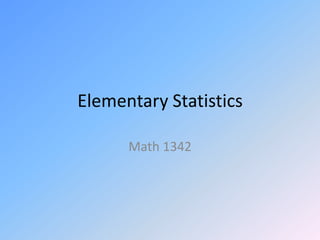
The nature of probability and statistics
- 1. Elementary Statistics Math 1342
- 2. Chapter 1 The Nature of Probability and Statistics • 1-1 Descriptive and Inference Statistics • 1-2 Variables and Types of Data • 1-3 Data Collection and Sampling Techniques • 1-4 Observational and Experimental Studies • 1-5 Uses and Misuses of Statistics • 1-6 Computers and Calculators
- 3. 1-1 Introduction Statistics is the science of conducting studies to collect, organize, analyze, and draw conclusions from data.
- 4. 1-1 Descriptive and Inference Statistics Descriptive Statistics consists of the collection, organization, summarization, and presentation of data. Inferential Statistics consists of generalizing from samples to populations, performing estimations and hypothesis tests, determining relationships among variables, and making predictions.
- 5. 1-1 Descriptive and Inference Statistics A Variable is a characteristic or attribute that can assume different values. Data are the values (measurements or observations) that the variables can assume. A collection of data values forms a data set. Each value in the data set is called a data value or datum. A population consists of all subjects (human or otherwise) that are being studied. A sample is a group of subjects selected from a population.
- 6. 1-2 Variables and Types of Data Variables can be classified as qualitative and quantitative. Qualitative variables are variables that can be placed into distinct categories, according to some characteristic or attribute. For example, a variable of gender (male or female) Quantitative variables are numerical and can be ordered and ranked. For example, a variable age. (17, 22, 80, etc) Discrete variables assume values that can be counted. Continuous variables can assume an infinite number of values between any two specific values. They are obtain by measuring.
- 7. 1-3 Variables and Types of Data Levels of Measure: Nominal Classifies data into mutually exclusive (non-overlapping) exhausting categories in which no order or ranking can be imposed on the data. Example 1: Teachers classified according to subject (Math, English, History, etc.) Example 2: Classify according to zip codes Example 3: Classify according to marital status (single, married, divorced, widowed, separated) Ordinal Classifies data into categories that can be ranked; however, precise differences between the ranks do not exist. Example 1: Student evaluations (superior, average, or poor) Example 2: Letter grades (A, B, C, D)
- 8. 1-3 Variables and Types of Data Levels of Measure: Interval Ranks data, and precise differences between units of measure exists. No meaningful zero. Example: IQ Test (There is a precise difference between an IQ of 109 and an IQ of 110 but an IQ test does not measure people with no intelligence) Ratio Possesses all the characteristics of interval measurement, and there exists a true zero. Example: measure of height, weight, area, and number of phone calls received.
- 9. 1-3 Data Collection and Sampling Random Subjects are selected by random numbers. Systematic Subjects are selected by using kth number after the first subjects is randomly selected from 1 through k. Stratified Subjects are selected by dividing up the population into groups (strata), and subjects within groups are randomly selected. Cluster Subjects are selected by using an intact group that is representative of the population.
- 10. 1-4 Observational and Experimental Studies Observational study Researcher merely observes what is happening or what has happened in the past and tries to draw conclusions based on these observations. Experimental study Researcher manipulates one or two variables and tries to determine how the manipulation influences other variables. Independent variable In an experimental study, Independent variable is the one that is being manipulated by the researcher. The resulting variable is called Dependent variable. Confounding variable is the one that influences the dependent or outcome variable but can not be separated from the independent variable.
- 11. 1-5 Uses and Misuses of Statistics “These are three types of lies……lies, damn lies, and statistics” “Figures don’t lie, but liars figure” Here are some ways that statistics can be misrepresented: •Suspect Samples … the size of the sample … how was the sample selected •Ambiguous Averages … median … mode … midrange •Changing the Subject … what is better to hear, 3% or $6,000,000, when both are correct? •Detached Statistics … Our brand of crackers has one-third fewer calories. •Implied Connections •Misleading Graphs •Faulty Survey Questions
- 12. 1-6 Uses and Misuses of Statistics •Implied Connections … Eating fish may help to reduce your cholesterol •Misleading Graphs … drawn inappropriately. •Faulty Survey Questions … For a survey, should the question be: “Do you feel that San Benito CISD should build a new football stadium?” or “Do you favor increasing school taxes so San Benito CISD can build a new stadium?”
- 13. Lecture Notes 1 1. Descriptive and inferential statistics. Descriptive describes a set of data. Inferential statistics uses a set of data to make predictions about populations. 2. Probability deals with events that occur by chance. It is used in insurance and gambling. 3. Gambling, insurance, education, etc. 4. A population is the totality of all subjects under the study. A sample is a subgroup of the population. 5. When the population is large, the researcher saves time and money using samples.
- 14. Lecture Notes 1 6. a) Inferential b) Descriptive c) Descriptive d) Descriptive e) Inferential f) Inferential g) Descriptive h) Inferential
- 15. Lecture Notes 1 7. a) Ratio b) Ordinal c) Ratio d) Interval e) Ratio f) Ordinal g) Ratio h) Ratio i) Nominal j) Ratio
- 16. Lecture Notes 1 8. a) Quantitative b) Qualitative c) Quantitative d) Quantitative e) Qualitative f) Quantitative g) Qualitative
- 17. Lecture Notes 1 9. a) Discrete b) Continuous c) Continuous d) Continuous e) Discrete f) Discrete g) Continuous
- 18. Lecture Notes 1 10. a) 42.75-42.85 b) 1.55-1.65 c) 5.355-5.365 d) 17.5-18.5 e) 93.75-93.85 f) 39.5-40.5
- 19. Lecture Notes 1 11. Random, systematic, stratified, cluster. 12. a) Cluster b) Systematic c) Random d) Systematic e) Stratified